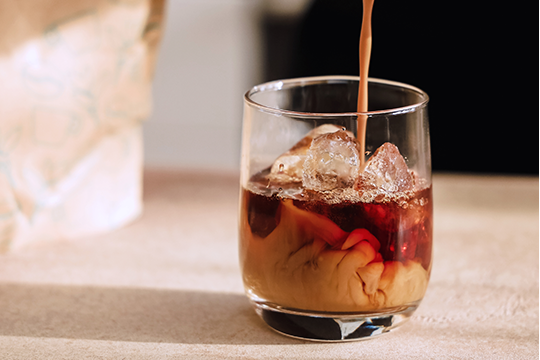When it comes to brewing the perfect iced coffee, no method captures freshness and flavor quite like the Japanese iced coffee method — also known as flash brew. Unlike traditional cold brew, which takes hours of steeping, this technique brews coffee hot and chills it instantly over ice, locking in its vibrant aromatics and crisp acidity. The result? A bright, aromatic cup that tastes just as complex as your favorite hot pour-over — only refreshingly cold.
Let’s break down what makes Japanese iced coffee special, how to brew it at home, and why it’s become the go-to method for baristas around the world.
What Is Japanese Iced Coffee?

The Japanese iced coffee method originated in Japan, where coffee culture emphasises clarity, precision, and balance. It’s based on the idea that hot water extracts the full range of coffee’s flavours — including those that cold brew often misses — and that immediately cooling it over ice “freezes” those flavours in place.
Unlike cold brew, which is brewed with cold water for 12–24 hours and results in a smooth but muted cup, Japanese iced coffee uses half the usual amount of water, replacing the other half with ice. As the hot coffee drips onto the ice, it melts and dilutes perfectly, creating a chilled coffee that maintains the brightness and complexity of a fresh brew.
In short:
- Cold brew = mellow, chocolatey, low-acid
- Japanese iced coffee = crisp, lively, aromatic
The Ideal Brew Ratio
Because ice contributes to the total water content, you’ll need to adjust your ratio. A good starting point is:
1:15 coffee-to-water ratio (by weight)
For Japanese iced coffee:
Use 40% ice and 60% hot water.
Example: 20g of coffee 240g total water → 140g hot water + 100g ice in the server
This ensures that once the ice melts, the final coffee maintains the correct strength and balance.
What You’ll Need
You don’t need any fancy gear — just the basics for pour-over brewing:
- Freshly roasted coffee (medium to light roast works best)
- Burr grinder Scale (for accuracy)
- Gooseneck kettle
- Pour-over dripper (Hario V60, Kalita Wave, or Origami Dripper)
- Paper filter
- Ice and a carafe or glass server
Optional: chilled glass and a slice of citrus peel for serving flair.
Step-by-Step: How to Brew Japanese Iced Coffee

1. Grind and Prep
Grind your coffee slightly finer than for a standard pour-over — about medium-fine. The faster extraction helps balance out the dilution from ice.
Place 100g of ice into your carafe or server. Rinse your paper filter with hot water to remove any papery taste, then discard the rinse water.
2. Bloom Phase
Add 20g of ground coffee into the filter. Pour about 40g of hot water (roughly twice the coffee weight) to bloom the grounds for 30–45 seconds. This releases trapped CO₂ and preps the coffee for even extraction.
3. Pour and Brew
Slowly pour the remaining 100g of hot water in circular motions over the next 2–3 minutes. Aim for a total brew time of around 3 minutes.
As the coffee drips through, it lands on the ice, melting it and cooling the brew instantly.
4. Swirl and Serve
Once the dripping stops, swirl the carafe gently to mix the melted ice and coffee evenly. Pour the chilled brew into a glass filled with fresh ice.
You’ll notice a bright aroma and a refreshing, clean finish — the hallmark of well-made Japanese iced coffee.
Flavour Profile
Japanese iced coffee has a distinct personality that sets it apart from other iced coffee styles:
- Aroma: Retains floral and fruity notes usually lost in cold brew.
- Acidity: Lively and balanced — think citrus, apple, or berry tones.
- Body: Light to medium, crisp rather than heavy.
- Finish: Clean and refreshing, with lingering sweetness.
It’s perfect for showcasing single-origin coffees like Ethiopian, Kenyan, or Colombian beans, where brightness and aroma take center stage.
Japanese Iced Coffee vs. Cold Brew
| Feature | Japanese Iced Coffee | Cold Brew |
|---|---|---|
| Brew Time | 3–4 minutes | 12–24 hours |
| Brew Temp | Hot (90–96°C) | Cold (4–10°C) |
| Flavour Profile | Bright, fruity, complex | Smooth, chocolatey, mellow |
| Body | Light to medium | Heavy and creamy |
| Aroma | Intense, vibrant | Soft, muted |
| Best For | Fruity single origins | Dark or medium roasts |
While cold brew is ideal for creamy, chocolate-heavy coffees, the Japanese method shines when you want your cup to feel refreshing, nuanced, and expressive — almost like a chilled pour-over.
Pro Barista Tips

- Use fresh ice. Old ice can pick up freezer odours and dull the flavour.
- Experiment with roast levels. Light and medium roasts bring out fruit and florals; dark roasts create caramel-like depth.
- Pre-chill your carafe. This prevents early melting and helps maintain consistency.
- Adjust grind and ratio. Too sour? Grind finer or reduce ice. Too bitter? Grind coarser or increase ice ratio.
- Serve immediately. Japanese iced coffee is at its best fresh — the flavours fade as it sits.
Once you’ve mastered the base technique, try these café-worthy upgrades:
- Citrus Iced Coffee: Add an orange or yuzu peel to your glass for a zesty twist.
- Vanilla Cold Foam: Top your iced coffee with lightly whipped milk foam and a dash of vanilla syrup.
- Sparkling Iced Coffee: Mix with chilled soda water for a refreshing fizz.
- Iced Coffee Tonic: Combine with tonic water for a bittersweet, botanical profile.
Each variation highlights how versatile Japanese iced coffee can be — equally suited for purists and creative baristas.
Why It Works
The secret behind Japanese iced coffee’s brilliance lies in temperature shock. Hot water extracts a wider range of flavour compounds than cold water ever could — especially the aromatic and acidic ones that give coffee life. By rapidly cooling the brew, you preserve those volatile compounds before they evaporate or oxidise.
It’s chemistry meets craftsmanship — and it’s why many baristas swear that flash brew captures the “truest” version of their beans.
Final Thoughts
The Japanese iced coffee method is proof that simplicity and precision can create extraordinary results. It celebrates what coffee is at its core — fresh, aromatic, and beautifully complex — just in a colder, more refreshing form.
So next time the temperature rises or you crave a crisp, sophisticated cup, skip the cold brew and give this method a try. It only takes a few minutes but delivers the clarity and elegance that make Japanese coffee culture so beloved.
Brew it mindfully, serve it chilled, and enjoy the harmony between heat and ice — the essence of Japanese iced coffee perfection.

Leave a Reply